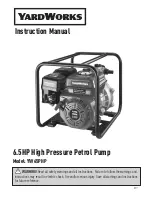
4 Transportation and Storage
4.1 Transporting the vacuum pump
WARNING
Risk of serious injury from swinging, toppling or falling objects
During transport, there is a risk of crushing and impact on swinging, toppling or falling objects. There
is a risk of injuries to limbs, up to and including bone fractures and head injuries.
► Secure the danger zone if necessary.
► Pay attention to the center of gravity of the load during transport.
► Ensure even movements and moderate speeds.
► Observe safe handling of the transport devices.
► Avoid sloping attachment aids.
► Never stack products.
► Wear protective equipment, e.g. safety shoes.
NOTICE
Equipment damage from operating fluid leaking into the pumping system.
If the vacuum pump is tipped, the operating fluid will overflow into the pumping system, resulting in
the vane breaking when the vacuum pump is switched on.
► Always transport the vacuum pump horizontally or without operating fluid filling.
► Fill in the operating fluid only at the final installation location.
Pfeiffer Vacuum recommends keeping the transport packaging and original protective cov-
er.
General information regarding safe transport
1. Observe the weight specified on packaging.
2. Use personal protective equipment, e.g. safety shoes.
3. Use transport equipment (e.g. fork lift truck or lift truck).
4. Where possible, always transport or ship the product in the original packaging.
5. Be mindful of transport damage.
6. Always place the product on an adequately sized, level surface.
Transporting the vacuum pump with its packaging
1. Observe safe handling of manually operated transport devices.
2. Note the center of gravity of the load.
3. Use a fork lift truck or pallet truck to transport the vacuum pump on a pallet in its packaging.
4. Ensure harmonious movements and moderate speeds.
5. To protect the inside of the pump, leave both protective caps on the connections during transport.
2
1
Fig. 4:
Transporting the vacuum pump
1 Protective cap
2
Crane lug
Transportation and Storage
18/60
















































